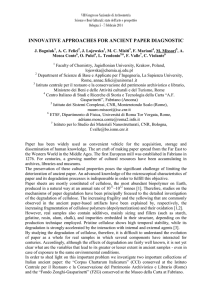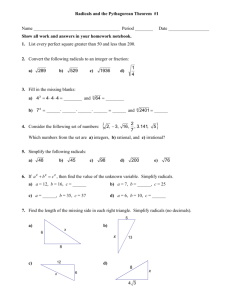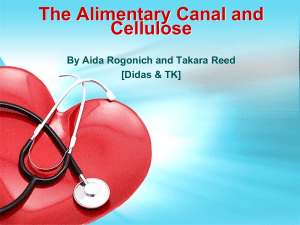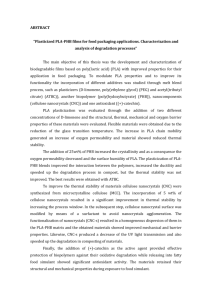Photo Oxidation of Paper Documents
advertisement
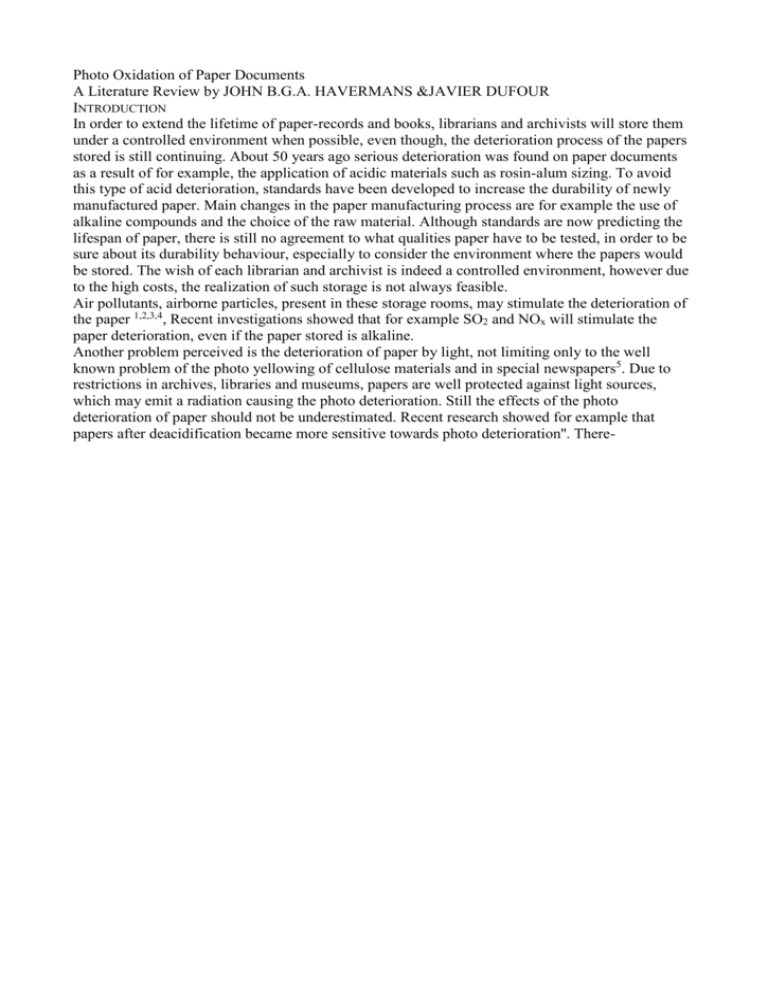
Photo Oxidation of Paper Documents A Literature Review by JOHN B.G.A. HAVERMANS &JAVIER DUFOUR INTRODUCTION In order to extend the lifetime of paper-records and books, librarians and archivists will store them under a controlled environment when possible, even though, the deterioration process of the papers stored is still continuing. About 50 years ago serious deterioration was found on paper documents as a result of for example, the application of acidic materials such as rosin-alum sizing. To avoid this type of acid deterioration, standards have been developed to increase the durability of newly manufactured paper. Main changes in the paper manufacturing process are for example the use of alkaline compounds and the choice of the raw material. Although standards are now predicting the lifespan of paper, there is still no agreement to what qualities paper have to be tested, in order to be sure about its durability behaviour, especially to consider the environment where the papers would be stored. The wish of each librarian and archivist is indeed a controlled environment, however due to the high costs, the realization of such storage is not always feasible. Air pollutants, airborne particles, present in these storage rooms, may stimulate the deterioration of the paper 1,2,3,4, Recent investigations showed that for example SO2 and NOx will stimulate the paper deterioration, even if the paper stored is alkaline. Another problem perceived is the deterioration of paper by light, not limiting only to the well known problem of the photo yellowing of cellulose materials and in special newspapers5. Due to restrictions in archives, libraries and museums, papers are well protected against light sources, which may emit a radiation causing the photo deterioration. Still the effects of the photo deterioration of paper should not be underestimated. Recent research showed for example that papers after deacidification became more sensitive towards photo deterioration''. There- fore this paper will present a review on the theoretical backgrounds of the effect of light on the deterioration of paper. PHOTO-DEGRADATION OF CELLULOSE Photo-degradation and photooxidation of cellulosic materials have been widely investigated, both in presence and in absence of oxygen. If high temperatures are involved, cellulose degrades by thermal oxidation7-8. Initially, at increased temperatures, cellulose radicals may form, and these may react with oxygen to produce, for example, hydroperoxide radicals (see Fig. 1). Fig. 1: Oxidation of cellulose and the forming of hydroperoxide radicals As oxygen reacts preferentially in the amorphous region, thermal oxidation will somewhat enhance the fraction of microcrystalline cellulose. According to Ha-vermans, due to thermal ageing both the crystalline fraction of the cellulose and the equilibrium moisture content will decrease4. Secondly, the hydroxyl groups present (C6-alcohol group and C2 and C3 alcohol groups), and the reducing end-groups are easily oxidized7'8'9, to give aldehydes and carboxyl groups. The ring structure of the glucose unit may remain intact. When the C1-H or C4-H bonds are attacked during oxidation, chain rupture will presumably result. Some major end products of this type of degradation include glucuronic acid, gluconic acid and aldaric acid. The thermal degradation of cellulose can also yield l,6-anhydro-(i-D-glucopyranose, and this reaction is used for a synthesis of this compound. This depolymerisation occurs rapidly if the material is exposed to microwave radiation10 (Fig. 2). Fig. 2: Synthesis of 1,6-anhydro-b-d-glucopyranose from (1→4)glucans using microwave radiation (according to Straathof et al., 1988) Dehydration reactions may also occur, and these may be classified as: • intermolecular dehydration (cross-linking), and, • intramolecular dehydration (formation of double bonds, monomers may dehydrate to give furan systems). Dehydration reactions generally occur in an acid environment, hence this type of reaction is only of secondary interest in these investigations, depolymerization, where cellulose breaks up into smaller units under the influence of oxygen and increased temperature, mostly produces 1,6 anhydro-β-Dglucopyranose, also known as levoglucosan. An outline of the oxidation products which can be formed is given in Fig. 3. Fig. 3: Some carboxyl products formed after oxidation; 1) arabinonic acid; 2) erythronic acid; 3) glucuronic acid and 4) di-carboxilic acid structure. The first attempts to study the photo-degradation were carried out by exposure to sunlight. Yellowing was found due to such exposure, but different results were obtained when the sunlight was glass-filtered. In this case, sunlight could bleach the papers. This phenomena were due to the different light spectra involved in the tests, since glass filters out the far UV, and to temperature effects11. Only light which is absorbed by a molecule is effective for producing chemical changes. With highly purified cellulose there is no absorption in the visible region, but it also remains uncertain whether there is any specific absorption in the ultraviolet region, and if there is, what are the absorbing groups or chromophoric systems responsible12. Three degradation mechanisms can be differentiated: direct photolysis produced by wavelengths lower than 3400 Å, photosensitised degradation promoted by the presence of impurities or lignin, and photochemical initiation of free radicals13. Direct photolysis In direct photolysis, the rupture of the chemical bonds occurs by the absorption of light with a sufficiently high energy. The exact energy required will depend on the nature of the bond and the atoms involved. The cleavage of either carbon-carbon of carbon-oxygen bonds will require an energy of 80 to 90 kcal/mole. Removal of hydrogen atom require about 100 to 110 kcal/mole. This energy requirements will be met by ultraviolet light of wavelength 3400 Å or shorter, which corresponds to 84kcal14. Actually, there is no doubt that wavelengths greater than 3100 Å are unable to photolyse pure cellulose directly12. In this way, a mercury vapour lamp emitting 2537 Å is capable of inducing photo-degradation processes. Experiments using cotton cellulose and an irradiation of 2537 Å at 40° C, showed not only a decrease in the DP, but also the formation of aldehyde or keto-carbonyl groups15 and carboxyl groups16 as well as the formation of carbon dioxide, carbon monoxide and hydrogen. Also, the presence of acetaldehyde, pro-pionaldehyde, acetone and methanol has been detected by Desai17. Many attempts have been developed for elucidating the reaction mechanism. It was concluded that the primary photolytic process consists of a chain scission between the anhydroglucose units and the formation of gaseous products is a secondary process18. However, the reaction mechanism is still quite uncertain. Several groups have been proposed as chromophores for the primary absorption process. Studying the decomposition gases, carbon monoxide, carbon dioxide and hydrogen were observed19. An explanation of the source of hydrogen formation is the photolysis of alcohol groups according to reaction: R-C-OH + Hv → R-C=O + H2 (1) This can be a fact, that using unfiltered light from a mercury lamp (185 nm was used), the radiation could promote n → Rydberg transitions at lactol and hydrox-yl oxygen centres. Also, carbonyl and carboxyl groups formed during sample preparation, impurities or products of secondary photo-oxidative processes have been suggested14. Actually, it is generally accepted that the acetal group at the Cl position of the anhydroglucose unit exerts a chromophoric effect, which in high molecular weight polysaccharides produces a band absorption and thus induces direct photolysis reactions12,20,21. Anyway, in photooxidation processes, free radicals are involved as transient intermediates during the processes that subsequently lead to the formation of degradation or oxidation products. Kleinert reported in 1969 that peroxides were formed in cellulose after the irradiation with ultraviolet (UV) light in air or oxygen5. Hon concluded that the photooxidation of cellulose results in a decrease of the degree of polymerization of the cellulose, while chromophoric groups are formed. Also the author showed the formation of peroxide-type radicals using ESR spectroscopy22. However, the nature of the radicals depends on the irradiation spectra and the origin of cellulose23. The effect that acidity plays in this deterioration process is an important role. Wood cellulose was degraded using UV light. By means of UV absorption spectroscopy a bond was shown at 270nm at pH 12, however at pH 2, this bond was absent13. Malondialdehyde has been proposed to account for this behaviour. Also volatile acids were formed, however the majority of the soluble fraction of degradation products is composed of neutral sugars like D-glucose, cellotriose and D-mannose. The presence of moisture will gready influence the radical formation, however it was shown that at about 5.7% the yield of the radicals is at a minimum (the average moisture content of paper is generally 5-7%). Photosensitised degradation As most of the commercially grade papers are of wood cellulose, diere will be always a residue of hemicellulose (HC) and other impurities present in the fibres4,24. Besides, paper contains also an amount of fillers and odier additives. If a photosensitiser (A) is present in the paper, the light will absorb and the energy will be transferred. In case of triplet energy transfer, the triplet state may transfer both energy and spin angular momentum according to reaction (2). A(T1) + B(S0)→ A(S0) + B(T1) (2) Generally triplet photosensitisers are used to produce other triplets, however there is one important exception. O2 molecules exist in its ground state as a tri- plet, and its lower state excited state is a singlet. Direct conversion of O2 to this excited singlet state with light is again a forbidden process, but singlet oxygen can be produced using a triplet photosensitiser since the total spin is conserved during energy transfer. This singlet excited state O2 can add in one step to, for example, conjugated systems. If paper contains special components due to a post treatment like deacidifica-tion, the sensitivity towards oxidative deterioration can be enhanced. This is especially the case when compounds like ZnO or TiO2 are being used. Both transition-state metals can promote the oxidative deterioration of cellulose, especially in the case of high alkalinity. It is known for example, that aldoses and ketoses undergo rearrangements in alkaline solutions. So paper made from wood cellulose, thus containing aldose groups, may show for example the Lobry de Bruyn-Alberda van Ekenstrein transformation8. Here firstly an enolisation of the aldose will take place to an 1,2-enediol, which can be converted to either of the two C-2 epimeric aldoses or to a ketose. Also aldonic acids can be epimerised by alkali. Strong alkali will convert the end groups in polysaccharides to various carboxylic acids. (14) linked polysaccharides (cellulose and hemicellulose), are degraded by an endwise mechanism, the peeling reaction. This reaction occurs during for example alkaline pulping. The reaction start with the isomerisation of the end group to a ketose in which the glycosidic bond is in the betaposition with respect to the carbonyl group. Since this structure is labile in alkali, the glycosidic bond is cleaved with the removal of the end group. This is called the beta-alkoxy elimination. The eliminated group is tautomerised to a 4-deoxy-2,3-glycodiulose. The peeling reaction is terminated by a so-called stopping reaction, where a direct beta-hydroxy elimination from the 4 C-3 position is taken place. The 3-O-substi-tuted glycosides of (1-4) linked polysaccharides are rapidly stabilised in alkali through benzylic acid rearrangement because the beta-alkoxy elimination takes place much easier than the beta-hydroxy elimination. The cleavage of glycosidic bonds by alkali is usually slow in comparison with the acid-catalysed hydrolyses. Photochemical initiation of free radicals A different type of free radical, formed in irradiated cellulose was demonstrated by Phillips et al. using cotton cellulose13. Their results showed a maximum free radical concentration induced by light ranging between 3250 and 4000 Å (with a maximum at 3600 Å) and did not show absorption by any one specific chromo-phore. If an impurity in the purified cotton cellulose were responsible for the absorption, it could be reasonably expected that the impurity would have a more specific absorption than that observed. It is suggested that the free radicals obtained in this study resulted from an intermediate state in which the electrons are in a excited band. Such radicals are unaccompanied by chemical changes. Thus, it was proposed a semiconductor-type model for excited cotton cellulose. PHOTO-DEGRADATION OF GROUNDWOOD-CONTAINING PAPERS The presence of lignin promotes the formation of free radicals and chemical oxidation when wood cellulose is exposed to ultraviolet light. For example high yield mechanical and or chemimechanical pulps are susceptible to photo-oxida-tive reactions which cause the pulps to become discoloured and loose brightness. The energy responsible for the initiating of the chromophore forming reactions is that absorbed 290 and 400 nm in the UV spectrum25. Specially, the 330-385 nm region of the sunlight spectrum causes the largest amount of yellowing. Window glass that filters most UV-B radiation in sunlight can therefore still transmit wavelengths that can cause considerable amounts of yellowing or brightness reversion26. Yellowing of lignin-containing pulps occurs and the changes have been attributed to the formation of keto, aldehyde and carboxylic groups. Lignin is suggested to take up the role of sensitiser. Radicals formed on the cellulose backbone and the nature and concentration of such radicals varies with the lignin content. Recently, it has been proposed mat guaiacyl-glycerol-β-O-4-guaiacyleter groups in lignin undergo hydrogen abstraction from the benzylic carbon by light induced peroxyl or alkoxyl free radicals to form ketyl free radicals. These ketyl radicals undergo rapid cleavage of the (β-aryl ether bond to produce phenoxy free radical and an enol which tautomerises to the aromatic ketone27. In the presence of air, these phenoxy radicals can form quinones, which act as chromophore25,28,29,30. The rapid formation of o-quinones during the early phase of irradiation, followed by a dramatic reduction of these species at later phase, has been detected. These oquinones react with neighbouring lignin groups creating other more complex chromophores which do not have quinoid character31. However, the nature of the radicals and the following reactions depends on the external atmosphere. Whether the irradiation is carried out in the absence of oxygen, the produced free radicals combine to increase molecular weight. On the other hand, the presence of oxygen inhibits the condensation, probably due to the combination of light induced carbon-centred free radicals with oxygen to form peroxy free radicals32. The yellowing or brightness reversion of high-lignin pulps upon light exposition is the biggest obstacle to the use of these pulps when no discoloration is required. Some solutions have been proposed to solve this problem as the use of additives which absorb UV radiation and free radicals scavengers33,34. However, many articles have been published showing that the responsible reactions of colour reversion are not the same reactions that decrease the mechanical permanence of paper35,36. These papers were excluded from the standard for permanence due to their apparent instability, but this was due to the acidic papermaking conditions used for their production37,38,39,40. Thus, the high quality lignin-containing pulps can be used as components for papers that will maintain physical properties during long term storage, because the produced yellowing does not affect the readability41. POST-IRRADIATION EFFECTS The post-degradation effect due to UV irradiation is known from many years ago. Launer and Wilson observed that paper irradiated under conditions that would result in bleaching (3300-4400 A), yellowed after storage for 15 months42. The yellowing was greater in the areas which had been irradiated than in the areas which had been blanked from irradiation. Sailings and Van Nostrand43 also found a post-irradiation effect using cotton linters and a quartz mercury arc. The irradiation was carried out in nitrogen atmosphere. When the samples were stored in oxygen, degradation continued for some time. The post-photoageing degradation could be deferred by storing the samples in nitrogen. Launer and Wilson did not find the effect of the oxygen and attributed the observations of Stillings and Van Nostrand to the presence of near ultraviolet irradiation in their source. This post-ageing effect is greatly accelerated by increasing the temperature. The nature of the post-irradiative changes depends largely on the history of irradiation. When the materials are irradiated in vacuum or in the presence of inert gases, these delayed changes were greater than those produced when the sample is exposed in the presence of oxygen. The postirradiation changes are progressively diminished as the duration of the exposure in the presence of oxygen is increased14. All these facts indicate that the radicals formed during the irradiation of cellulose are the responsible ones for the post-degradation effect. These effects are due to the subsequent interaction between these radicals and the oxygen in the surrounding atmosphere leading to further degradation. The mechanism is given below. This mechanism explains why the post-degradation is inhibited in nitrogen atmosphere. Propagation reaction (reaction 3) can not be produced in absence of oxygen. CONCLUSIONS AND RECOMMENDATIONS This literature review on the oxidative deterioration of cellulose and paper shows, that under no circumstances may this degradation type be ignored. Although the presence of direct light can be avoided often during consulting archival documents and books, there will still be a risk of forming initiators causing further deterioration. The extent of this risk is however until now unknown. Alkali compounds may promote the oxidative deterioration, however, this deterioration type is from a lower degree than that of the acid hydrolyses type. Therefore it is to be recommended to carry out research on the effects on the oxidative and alkaline deterioration of paper, especially for naturally aged papers which are de-acidified. Furthermore it has to be considered if the present accelerated ageing methods for paper will be valid for promoting both types of degradation mechanisms. ACKNOWLEDGEMENT The Complutense University of Madrid (Spain) is highly acknowledged for funding partly this work. SUMMARIES Photo Oxidation of Paper Documents. A Literature Review The problem of the photo yellowing of cellulose materials and in special newspapers is well known. Due to restrictions in archives, libraries and museums, papers are well defended against light sources, which may emit a radiation causing the photo deterioration. Still the effects of the photo deterioration of paper should not be underestimated. This paper presents a review on the theoretical backgrounds of the effect of light on the deterioration of paper and shows, that although the presence of direct light can be avoided often during consulting archival documents and books, the risk of forming initiators causing further deterioration should not be ignored. The extent of this risk is however until now unknown. Therefore it has to be recommended to carry out research on the effects on the oxidative and alkaline deterioration of paper, especially for naturally aged papers which are deacidified. Photo-oxydation du papier. Un rapport litteraire Le probleme du jaunissement du papier et en particulier du papier journal sous l'influence de la lumiere est un phenomene bien connu. Grace aux reglementations en vigueur les objets deposes dans les archives, les bibliotheques et les musees sont proteges des sources de lumiere qui sont susceptibles de provoquer une radiation causant la deterioration du papier. Cependant il ne faut pas sous-estimer la deterioration du papier induite par la lumiere. On presentera un apercu sur les arriere-plans theoriques du phenomene et on montrera que, meme si on evite d'exposer les documents et les livres que Ton consulte a 1'incidence directe de la lumiere, il ne faut cependant pas ignorer qu'un risque de deterioration existe toujours. A l'heure actuelle il n'est pas encore possible de mesurer l'ampleur de ce risque. C'est pourquoi de nouvelles recherches s'imposent sur la deterioration oxydative et alcaline du papier, en particulier en ce qui concerne les vieux papiers qui ont ete desacidifies. Lichtinduzierte Oxidation von Papier. Ein Literaturbericht Das Problem der Vergilbung von Papier, insbesondere Zeitungspapier unter Lichteinfluß ist wohlbekannt. In Archiv, Bibliothek und Museum gelten Vorschriften, die die Objekte vor Lichtquellen schützen, welche eine von ihnen ausgehende Oxidation bewirken können. Dennoch soil-ten die Folgen des lichtinduzierten Abbaus von Papier nicht unterschätzt werden. Es wird ein Überblick über den theoretischen Hintergrund des Phanomens geboten, und es wird gezeigt, daß, auch wenn direkter Lichteinfall beim Einblick in das Objekt vermieden wird, dennoch die Gefahr besteht, daß ein weiterer Abbau ausgelöst wird. Das Ausmaß dieser Gefahr ist bislang freilich nicht bekannt. Es sind deshalb weitere Forschungen angebracht zum oxidativen und zum alkalischen Abbau von Papier, besonders fur alte Papiere, die neutralisiert wurden. REFERENCES 1. Nazaroff, W. W., & G. R. Cass: Mathematical Modelling of Chemically reactive Pollutants in Indoor Air. Environment Science and Technology 20 (1986): 924-934. 2. Nazaroff, W. W., et al.: Airborne particles in Museums. Marina del Rey, Getty Conservation Institute (1993). 3. Havermans, J. B. G. A., et al: The Effects of Air Pollutants on the Accelerated Ageing of Cellulose Containing Materials - Paper. EC/DGXII/STEP Project CT 90-0100, TNO, Delft, The Netherlands (1994). 4. Havermans, J. B. G. A.: Environmental influences on the deterioration of paper. Rotterdam: Barjes-teh, Meeuwes & Co 1995. 5. Kleinert, T. M.: Altern und Vergilben von Cellulose. Holzforschung und Holzverwertung 21 (1969): 133-134. 6. Havermans, J. B. G. A., & R. J. P. yan Deventer: Mass deacidification of archival materials. The DEZ and Battelleprocess compared. IFLA Satellite meeting on conservation, Budapest, Hungary, December 1995. 7. Fengel, D., & G. Wegener: Wood, chemistry, ultrastructure and reactions. Berlin: Walter de Gruy-ter 1989. 8. Sjöström, E.: Woorf Chemistry. Fundamentals and Applications. Boston: Academic Press, INC 1993. 9. Blazej, A. & M. Kosik, Eds.: Degradation reactions of cellulose and lignocellulose. Cellulose and its Derivates. New York: John Wiley & Sons 1985. 10. Straathof, A. J. J., H. v. Bekkum & A. P. G. Kieboom: Preparation of 1,6-anhydroglucose from (1 -4)-Glucans using Microwave Technology. Recueil des Travaux Chimiques des Pay-Bas 107,11 (1988): 647-648. 11. Rapson, W. H., & I. H. Spinner: Brightness reversion in bleached pulps. Tappi Monographs 27 (1965): 273-309. 12. Phillips, G. O. Ed.: The effects of eight on cellulosic systems. Cellulose and its Derivates, New York: John Wiley & Sons 1985. 13. Phillips, G. O., O. Hinojosa, J. C. Arthur & T. Mares: Photochemical initiation of free radicals in cotton cellulose. Text. Res. J. 36 (1966): 822-827. 14. Desai, R. L.: Photodegradation of cellulosic materials. A review of literature. Pulp Paper Mag. Can. August 1968): 53-61. 15. Bos, A.: The UV spectra of cellulose and some model compounds.]. Appl. Polym. Sci. 16 (1972): 2567-2576. 16. Daruwalla, E. H., A. P. D'Silva & A. C. Mekta: Photochemistry of cotton and chemically modified cotton. Part I: behaviour during exposure to carbon-arc and solar radiations. Text. Res. J. 37,3 (1967): 147-160. 17. Desai, R. L.: Photodegradation of cellulose. A surface effect. Pulp Pap. Mag. Can. 71 (1970): 305. 18. Buschle-Diller, G., & S. H. Zeronian: Weathering and photodegradation of cellulose. In: Heitner, C, &J. C. Sciano, eds. Photochemistry if Iignocellulosic Materials, Washington: American Chemical Society 1993: 177-189. 19. Flynn, J. G., W. K. Wilson & W. L. Morrow: Degradation of cellulose in a vacuum with ultraviolet light.}. Res. Nat. Bureau Standards 60, 3 (1958): 229-233. 20. Beélik, A., &J. K. Hamilton: Eine Untersuchung des wasserloslichen Anteils UV-bestrahlter Zellstoffe. Das Papier 13 (1959): 77-85 21. Beélik, A., &J. K. Hamilton: The ultraviolet Irradiation of model compounds related to cellulose:]. Org. Chem.: 26 (1961): 5074 22. Hon, D. N. S.: Photooxidative degradation of cellulose: reactions of the cellulosic free radicals with oxygen.]. Polym. Sci. A: Polym. Chem. 17 (1979): 441-454. 23. Hon, D. N. S.: Formation of free radicals in photoirradiated cellulose and related compounds. ]. Polym. Sci. 14 (1976): 2513-2525. 24. Havermans, J. B. G. A.: Onderzoek naar het karakleriseren van papier en papierveroudering met infrarood-spectroscopie. Delft, The Netherlands: TNO 1991. 25. Lennholm, H., G. Lindblad et al.: A study of the mechanism of the photo-yellowing of partially acety-latedgroundwoodpulps. Nordic Pulp Paper Res.J. 3 (1992): 108-112. 26. Andrady, A. L., & N. D. Searle: Photoyellowing of mechanical pulps; activation spectra for light-induced yellowing of newsprint paper by polychromatic radiation. Tappi J. 5 (1995): 131-138. 27. Schmidt, J. A., & C. Heitner: Light-induced yellowing of mechanical and ultra-high yield pulps. Part 2. Radical-induced cleavage of etherified guaiacylglucerol-ji-arylether groups is the main degrada-tivepathway.]. Wood Chem. Technol. 13,3 (1993): 309. 28. Arney, J. S., & A.J.Jacobs: Newsprint deterioration. The influence of temperature on the relative contribution of oxygen-independent and oxygen-dependent processes in the total rate. Tappi Journal 63,1 (1980): 75-77. 29. Forsskähl, I., &J. Janson: Sequential treatment of mechanical and chemimechankal pulps with light andheat. Part 7. UV-VISreflectance spectroscopy. Nordic Pulp Paper Res.J. 3 (1991): 118126. 30. Forsskähl, L, &J. Janson: Sequential treatment of mechanical and chemimechankal pulps with light and heat. Part Z. FTIR and UV-VIS absorption-scattering spectra, Nordic Pulp Paper Res. J. 2 (1992): 48-54. 31. Wang, J., C. Heitner & R. S. J. Manley: Photodegradation of milled wood lignin. Part III: effect of solvent and light intensity, 8th Inter. Symp. on Wood and Pulping Chemistry, 199.5: 27-31. 32. Destiné, J. N., J. Wang, C. Heitner & R. S. J. Manley: The photodegradation of milled-wood lignin. Part I: the role of oxygen.]. Pulp Paper Sci. 22, 1 (1996): J24-J30. 33. Bailey, A. L., & L. J. Lamont: A standard procedure for accelerated testing and measurement of yellowing by light in papers containing lignin. TappiJ. 76, 9 (1993): 175-180. 34. Wang, J., C. Heitner & R. S. J. Manley: The photodegradation of milled-wood lignin. Part II. The effect of inhibitors.]. Pulp Paper Sci. 22, 2 (1996): J58-J63. 35. Priest, D. J., &J. Stanley: The permanence of papers containing modern high yield pulps. Products of Papermaking, Oxford, PIRA International 1992: 1315-1353. 36. Zou, X., N. Gurnagul & T. Uesaka: The role of lignin in the mechanical permanence of paper. Parti: effect of lignin content.]. Pulp Paper Sci. 19, 6 (1993):J235-J239. 37. Talavera, I., & R. Molina: Evaluation y estudio de mezclas fibrosas en papeles de aha permanencia y durabilidad Inv. Tec. Papel 97 (1988): 542-553. 38. Talavera, I., & R. Molina: Envejecimiento acelerado en las formulaciones fibrosas para papeles per-manentesy durables. Inv. Tec. Papel 100 (1989): 356-365. 39. Talavera, I., & R. Molina: Permanencia y durabilidad de papeles para escritura e impresidn con alto conlenido defibra corta de bagazo. Inv. Tec. Papel 101 (1989): 585-599. 40. Gurnagul, N., R. C. Howard, X. Zou, T. Uesake & D. H. Page: The mechanical permanence of paper: a literature review.]. Pulp Paper Sci. 19, 4 (1993): J160-J166. 41. Johnson, R. W., & A. Bird: CTMP in fine papers: impact of the permanence of alkaline papers. 1991 Papermakers Conference. Atlanta: TAPPI Press 1991: 267-273. 42. Launer, H. F., & W. K. Wilson: The photochemistry of cellulose. Effects of water vapour and oxygen in the far and near ultraviolet regions.]. Am. Ceram. Soc. 71 (1944): 958-962. 43. Stillings, R. A., & R. J. Van Nostrand: The action of ultraviolet light upon cellulose. I. Irradiation effects. II. Postirradiation effects.]. Am. Ceram. Soc. 66 (1944): 753-760. John B.G.A. Havermans TNO Institute of Industrial Technology, Paper Production Technology P.O. Box 6031 NL-2600JA Delft The Netherlands Javier Dufour Complutense University of Madrid, Dpt. Chemical Engineering Avda. Complutense s/n S-28040 Madrid Spain


